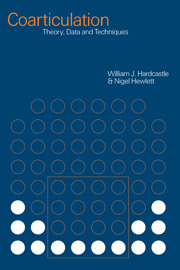Book contents
- Frontmatter
- Contents
- List of figures
- List of tables
- List of contributors
- Acknowledgments
- Introduction
- Part I Theories and models
- Part II Research results: components of the motor system for speech
- Part III Wider perspectives
- 8 Cross-language studies: relating language-particular coarticulation patterns to other language-particular facts
- 9 Implications for phonological theory
- Part IV Instrumental techniques
- References
- Index
9 - Implications for phonological theory
Published online by Cambridge University Press: 22 September 2009
- Frontmatter
- Contents
- List of figures
- List of tables
- List of contributors
- Acknowledgments
- Introduction
- Part I Theories and models
- Part II Research results: components of the motor system for speech
- Part III Wider perspectives
- 8 Cross-language studies: relating language-particular coarticulation patterns to other language-particular facts
- 9 Implications for phonological theory
- Part IV Instrumental techniques
- References
- Index
Summary
Delimiting the phonological
The topic of this chapter subsumes two broad questions. First, what do phonological models and representations developed for other purposes imply for our understanding of the coarticulatory patterns described in the previous chapters? Second, what do the coarticulatory patterns imply about the shape of phonological models and representations? Implicit in these questions is the assumption that coarticulation is properly in the purview of something other than ‘phonological theory’, and hence, that we can delimit some aspects of sound structure that are not ‘phonological’ but merely ‘phonetic’.
This assumption is not uncontroversial. For example, in the late 1970s and early 1980s, a series of articles in the Journal of Phonetics juxtaposed two diametrically opposed understandings of coarticulation, neither of which recognized this distinction between phonetic coarticulation and its phonological implications. First, Hammarberg (1976, 1982) proposed to define away the phonetics of coarticulation by ascribing the phenomena to phonological assimilation. That is, he described coarticulation as the accretion of context-dependent rewrite rules in the derivation of the surface representation of an utterance, the same mathematical formalism developed by Chomsky and Halle (1968) to account for morphological alternation and allophony. Fowler (1980, 1983b), on the other hand, rejected the phonological model of segmentation that Hammarberg's position required – namely, a serially ordered list of juxtaposed discrete alphabetic segments – along with the sequential derivational view that it required of the relationship between phonological and phonetic representations.
- Type
- Chapter
- Information
- CoarticulationTheory, Data and Techniques, pp. 199 - 226Publisher: Cambridge University PressPrint publication year: 1999
- 2
- Cited by



